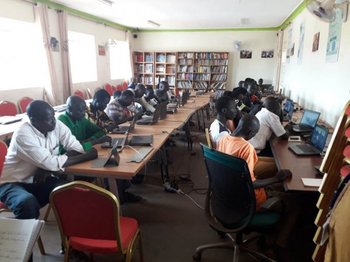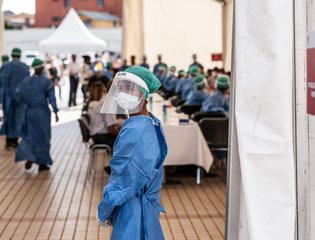Imagine being under mandatory lockdown for over two decades, with strict dusk to dawn curfew. What would life be like for you? While most of us have only endured mobility restrictions for a few months since the coronavirus was declared a global pandemic, this has been the norm for most refugees in Kenya since 1991, and has meant an inability to move freely out of the designated camp areas without a clear sight on when normal life will resume, with over 400,000 lives and livelihoods affected.
In June, I was joined by the Kenya Red Cross Society, Oracle, Agha Khan Media Innovation Centre and Gravity Earth in a webinar organised by Techfugees’ Kenya chapter to discuss the role of technology in disrupting existing refugee inequalities in Kenya amidst Covid-19.
A few days before the event, I had a chance to speak via phone to selected refugees in Kakuma and Dadaab, two of Kenya’s largest refugee camps. The conversations in Dadaab highlighted how the current situation has compounded refugee marginalisation. “All sectors have been affected,” one refugee told me, “all schools have closed, teachers are jobless. The hospitals are far from people and there is a water shortage.”

Dadaab Camp, Kenya. Photo credit: Flickr/Oxfam International
The situation is not any different in Kakuma. Health facilities, already stretched before the pandemic, are not well equipped. Health practitioners are not well prepared to handle epidemic-related patient loads. There are concerns about the availability of isolation facilities, ventilators, personal protective equipment and drugs for effective respiratory and cardiovascular support.
The indefinite closure of schools further marginalises refugee children and the government’s proposal of technology-mediated learning does not suit camp settings.
The indefinite closure of schools further marginalises refugee children, and the government’s proposal of technology-mediated learning does not suit camp settings. In 2018, through a study on “Innovating mobile solutions for refugees in East Africa”, we highlighted the potential of digital solutions in the Kakuma refugee camp, but my recent conversations with the refugees themselves shows this opportunity is yet to be fully exploited. The right solutions have not yet been found and rolled out.
Tackling inequality with digital technologies?
Our own work as researchers committed to identifying solutions has been affected by the pandemic. As in-person fieldwork becomes indefinitely impossible, I have found myself relying on remote technologies to obtain the very information that can have an impact. Since March at Samuel Hall we have been regrouping, exploring, and testing new ways of doing remote fieldwork. This has included using technology – phones and platforms such as WhatsApp – to conduct epistolary interviews, and receive photo and visual diaries of participants’ daily lives, including having refugees themselves taking a stronger role in framing and sharing their own narratives.
As we’ve switched to these methods, I have experienced the importance that access to technology has in highlighting these digital inequalities, and who is able to tell their story.
Despite the uncertainty of the refugee camp, a good number of refugees have taken it upon themselves to come up with initiatives to bridge the tech gap. I was lucky to be able to hear a few of these stories and bring some of their challenges to light.

Photo credit: Flickr/Penn State
In Dadaab, the Norwegian Refugee Council (NRC) has employed a digital marketplace as a coping strategy for businesses that are unable to access other markets. Through the platform, Nyota Farsamo, a group of Somali refugees that venture in handmade home décor items and other hand crafted products, have been able to sell and interact with online buyers.
Before the pandemic, most refugees in Kakuma and Dadaab depended on Community Technology Access (CTA) centres to get access to computers and the internet. Kakuma Ventures is a social enterprise founded by Innocent N. Tshilombo, a Congolese refugee, with the goal of helping his fellow refugees build businesses. Innocent has put in place an infrastructure to set WiFI spots in selected camp zones.
With the closure of main internet access centres, his WiFi hotspots are not only giving learners the opportunity to access learning materials but also supporting easy access of information and online business transactions for other community members. His final words to me were hopeful: “Personally I know technology is the only wing through which refugees can fly to reach various opportunities that are outside the walls of this camp.” As Innocent highlights, technology is key to unlocking opportunities and allowing refugees to share their own stories and productions. However, this only becomes possible if the platforms and infrastructure for accessing this is available – strengthening this access is more crucial now than ever.
